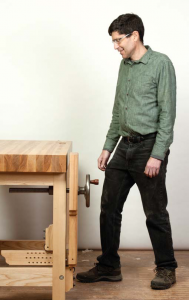We may receive a commission when you use our affiliate links. However, this does not impact our recommendations.
Woodworking fundamentals are what we all have in common – beginner, intermediate or advanced. We all use the basics. Some might say, in fact, that the only difference between expert and novice craftspeople is that the experts know and use their basic skills better than the novices.
One of the best days I had in my woodworking apprenticeship began when my mentor walked me through the hardwood stacks in the morning. We probably spent less than an hour looking at the lumber – it was a fast-paced shop and there was a lot to do – but I spent the rest of the day visualizing what I’d just learned about grain direction and wood types. I had new eyes.
It starts with the wood, so if you haven’t ever done it – or if it’s been a long time – I’d suggest you take one hour today and write down a list of questions that have been bothering you, then look up answers online or go to a good lumberyard and figure it out. Or even contact our editors – they’re always happy to answer woodworking questions! It’ll pay dividends in your work – not only with solid stock but also with high-quality veneers.
Next could be either tool talk or body mechanics. They are both fundamental topics that deserve a lot of attention. I think tool talk gets a few more column inches, so I suggest spending time this week on body mechanics.
I have two perspectives for you that should help. One of them – somewhat foreign to our Western perspective, but fun and useful – is Bob Lang’s Tai Chi method. You can read about it in the original magazine issue.
The other perspective is Jeff Miller’s 11-page chapter called “Using Your Body Correctly” in “The Foundations of Better Woodworking.” It’s short, sweet and well-written.
Today there’s a new DVD available based on Jeff Miller’s book, so I want to mention that as well. With the DVD you’ll get in-motion visuals to go with all the basic knowledge. I highly recommend either the DVD or the book in order to begin (or restart) your “fundamentals” journey the right way.
Then post a comment below and tell me how it’s going!
Here are some supplies and tools we find essential in our everyday work around the shop. We may receive a commission from sales referred by our links; however, we have carefully selected these products for their usefulness and quality.











Adam Cherubini wrote:
“When I’m working wide stock for a carcase side, I don’t worry if the stock is cupped or twisted a little. I can usually straighten the stock with the dovetails. ”
What does he mean by this? Can you elaborate please?